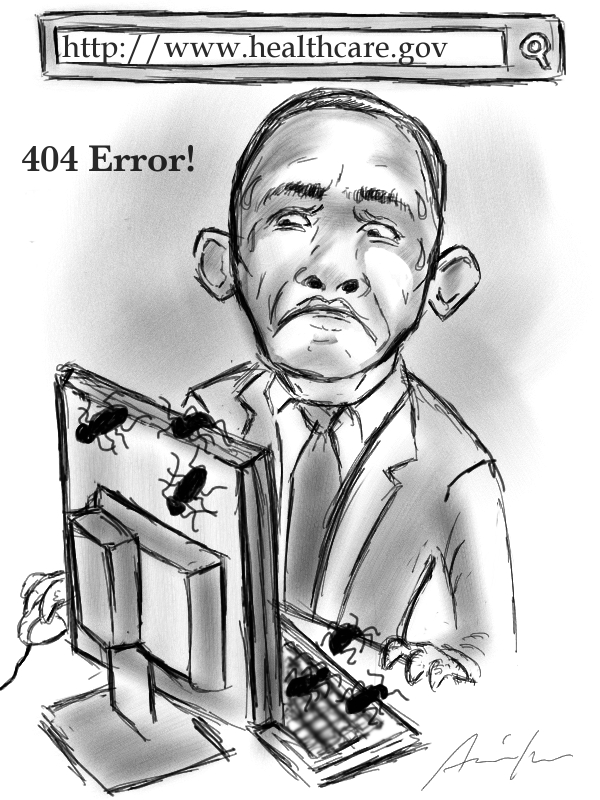Earlier this week, Obama delivered a defiant speech addressing the imbroglio surrounding the failed implementation of his Affordable Care Act. Immediately following his “victory” over the government shutdown, in which many Republicans attempted to topple his signature achievement from its heights, he found himself on the defensive due to the misadventures of his own administration. The reaction to his speech, in which the president refused to acknowledge the severity of the bugs plaguing healthcare.gov, was swift and uncompromising. The editorial boards of America’s three national newspapers, the New York Times, Wall Street Journal, and USA Today, each criticized the president on the day after his remarks, and the capital’s own Washington Post refused to exculpate Obama from “self-imposed incompetence.”
That the nation’s top media outlets refused to sugarcoat the failings of the president and his administration is a welcome sign. However, while the reactions of editorial boards and other card-carrying members of the punditocracy have not spared Obama from ultimate blame, critiques from each side do not manage to escape the inevitability of political spin. While opinion writers on the right use the website snafu as a prime example of the central government’s inability to administer an entire country’s healthcare industry, editorialists on the left view the blunder as an infuriating road bump with the potential to derail their prized progressive triumph. These reactions are not surprising, nor are they necessarily unpersuasive. But these boilerplate responses do demonstrate the media’s unalloyed tendentiousness and overarching refusal to address concerns beyond those that come straight from their respective talking points.
Obamacare has problems. More specifically, these problems reside in the elegantly named Obamacare website, on which America’s uninsured are expected to enter into the newly created healthcare exchanges. As such, while the relationship of this particular failure with the viability of the entire law is certainly relevant to national discourse, this should not take away from discussing the immediate issue—simplistically put, the government does not know how to create a website.
Harry Reid was referring to potential ACA enrollees when he explained away user difficulty with the portal, dismissively commenting, “If you’re over age 50, the Internet is something that you’re just learning about.” The Senate Majority Leader is not incorrect in this statement, although he would have a better grasp on its salience if he had made it while looking into a mirror. After all, Secretary of Health and Human Services Kathleen Sebelius, who was ultimately in charge of the healthcare rollout, is 65. Obama is 52. (And Reid is 73). No matter how “hip” Obama would like to be in the eyes of the youth vote, there is a strong chance that he knows less about how the Internet works than your 13-year old sister. And even on the off chance that his (staff’s) Instagram skills somehow outmatch those of your sister, I would venture to be that he knows less about the back end of computer programming than CS50 students after completing their Scratch assignments in “week 0.”
This is of course no mark against Obama. He was certainly not elected to be programmer-in-chief; even if CS aptitude had been a factor, he’d almost assuredly have had the upper hand over septuagenarian John McCain. However, this unveils an incipient issue engendered by the period shift into the Information Age—as the Internet becomes an increasingly essential component of our daily routines, the government must get with the program.
The opacity with which President Obama has treated the issues facing healthcare.gov is shameful, especially as the oft-repeated claim that the errors have resulted purely from traffic has been debunked. However, the president likely hasn’t a clue what an “834 EDI transmission” is, other than perhaps that it is thwarting the grandiosity of his achievement. For the most part, nor do we. But the fact that “traffic” is simply a more comprehensible concept does not excuse the disingenuousness of the assertion.
In its editorial on the matter, the New York Times opined, “The administration created the Web site so the buck necessarily stops with high officials—Kathleen Sebelius, the Secretary of Health and Human Services, and President Obama himself.” Sebelius initially refused to testify on the glitches, prompting calls for her resignation. While she now has agreed to answer questions before Congress, it is difficult to imagine what she can possibly say. How much does she know about the actual issues facing the site? There is no doubt that the House of Representatives received more substantive information from the contractors tasked with creating the site. While their testimonies offered juicy accounts of not being given enough time by the administration, they serve only to “pass the buck.” This is easy for them to do, considering they are not government officials and are not held publicly accountable.
It makes sense that Sebelius and Obama be held accountable—if even for the fact that they really did not heed the concerns of their programmers. But who were they to really know? As technology becomes integrated into other aspects of government, we need people in positions of authority to understand it. (Maybe Zuckerberg and Gates should advocate for teaching coding in government agencies rather than schools). One day, society will be such that the president and Secretary of Health and Human Services will have impeccable comprehension of computer programming. In the interim, let’s at least put someone in charge.
John F. M. Kocsis ’15, a Crimson editorial writer, is a government concentrator in Eliot House. His column appears on alternate Fridays. Follow him on Twitter @jfmkocsis.
Read more in Opinion
Fewer Existential Crises, More Babies













